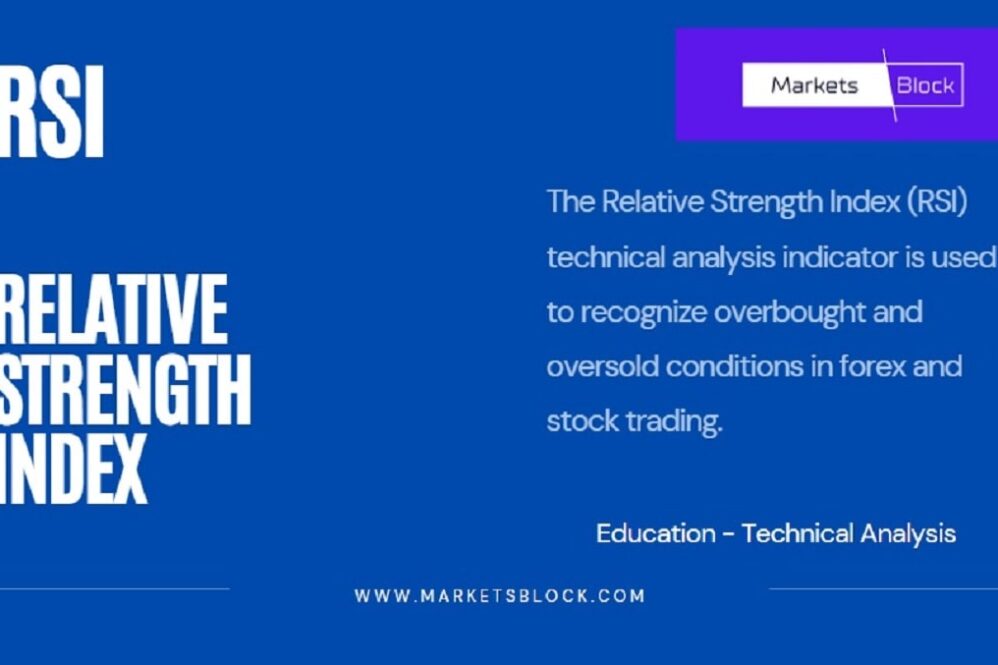The Relative Strength Index (RSI) technical analysis indicator is used to recognize overbought and oversold conditions in forex and stock trading. J. Welles Wilder Jr. developed the RSI index and present it in his 1978 book, “New Concepts in Technical Trading Systems.”
RSI could be applied to different time horizons and customised timeframes depending on the asset category and trading strategy. The Relative Strength Index (RSI) is usually based on a 14-day period horizon, but this can be adjusted accordingly to increase or decrease the sensitivity of the indicator. An analyst can decide the number of days for calculating the index. A 10-period RSI is more likely to reach faster overbought or oversold levels than a 20-period RSI as the more periods you use, the ‘slower’ the RSI will appear to react to recent price changes.
The Relative Strength Index (RSI) is a leading momentum indicator as it signals that a change in trend is imminent.
RSI moves between 0 and 100. So a Relative Strength Index of 0 means that the stock price has fallen in all of the 14 trading days. A Relative Strength Index of 100 means that the asset price has risen in all of the 14 trading days.
If you set the Relative Strength Index of 14 periods, it will measure the strength of this candle’s price movement against the previous 13 (for a total of the last 14 periods). If you use Relative Strength Index at 20 periods, you will be measuring this candles weakness or strength to the previous 19 periods. Traders can adjust the signal levels based on the specific asset conditions. For example, if the trend is unclear or the market consolidates, technical analysts may use the default RSI setting of 30 and 70. However, if the trend is strong, traders may adjust the levels to 20 and 80.
RSI and Trends
If RSI is 30 or below, we are in an oversold situation which increases the possibility of price strengthening. Technical analysts interpret that an oversold asset price is an indication that the downtrend is likely to reverse, which means it’s an opportunity to enter a long position preferably when the RSI index crosses back above the 30 mark.
If RSI is hovering above 70, indicates overbought conditions as the price action is bullish and increases the possibility of price weakening. An overbought security is an indication that the rising trend is likely to reverse, which means it’s an opportunity to sell.
Traders should be careful because a security or an index can get even more overbought or oversold. The RSI momentum indicator can stay for extended periods in overbought condition while the security is in an uptrend. Similarly, the indicator may also remain in oversold territory for an extended period when the stock is in a downtrend. Technical analysts usually interpret when the RSI line moving below the overbought line or above the oversold line as a signal to sell or buy .
A movement from below the 50 mark to higher levels indicates a rising trend targeting the 70 mark. In that case, the trend is gaining momentum and is seen as a bullish signal until the Relative Strength Index approaches the 70 mark. A movement from above the 50 to below, indicates a falling trend moving towards the 30 line. In that case, is seen as a bearish signal until the Relative Strength Index approaches the 30 mark.
Relative Strength Index is can also be used to confirm trend formations. If you think a new trend is forming, check the RSI and look at whether it is above or below the 50 mark. In a possible uptrend, make sure the indicator is above 50. If you are looking at a possible downtrend, then make sure the Relative Strength Index is below the 50 mark. To avoid fakeouts, we can wait until the RSI cross below 50 to confirm our trend. As the Relative Strength Index breaks below the 50 mark, it is a strong confirmation that a downtrend has started.
Relative Strength Index Divergences
When the price of an asset and the RSI behave differently we have Divergence. If the asset price is decreasing but the Relative Strength Index is increasing, it’s a sign of positive or bullish divergence. Similarly, when the asset price is increasing but the Relative Strength Index is falling, it’s a sign of negative or bearish divergence pointing to a market correction. In a few words, a bullish divergence, points to higher prices. If you see a bearish divergence, it could mean that the price might go down.

Nikolas has been involved in the finance industry for over fifteen years spanning across Europe and USA with a depth of knowledge and experience within many aspects of the financial markets. Nikolas gained several years experience with some of the Europe’s leading Brokers, as equity analyst, and trader managing accounts for both Private and Corporate Investors. He enjoys both the fundamental and technical aspects of trading focusing on stock markets and all FX majors. Currently, Nikolas provides analysis and comments to online financial publications. Educational background in Economics (BSc), and Finance (MSc).









